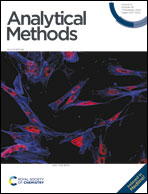A study on the effects of tumor-derived exosomes on hepatoma cells and hepatocytes by atomic force microscopy
Abstract
Tumor-derived exosomes (exos) are closely related to the occurrence, development and treatment of tumors. However, it is not clear how the exosomes affect the physical properties, which lead to the deterioration of the target cells. In this paper, atomic force microscopy (AFM) was used to study the effects of exosomes in HCC-LM3 cells and other cells (SMMC-7721 and HL-7702). The results showed that the HCC-LM3-exos (the exosomes secreted by HCC-LM3 cells, 50 μg mL−1) significantly promoted the proliferation and migration of HCC-LM3 cells. HCC-LM3-exos also promoted the proliferation and migration of SMMC-7721 and HL-7702 cells at 1000 and 1500 μg mL−1, respectively. With an increase in time and concentration, the proliferation effect was more significant. On comparing the mechanical properties of the three types of cells (HCC-LM3, SMMC-7721 and HL-7702 cells), the degradation degree and migration ability of the cells were from high to low in the above order. In turn, the surface roughness of the cells decreased, and adhesion and elastic modulus increased. With an increase in treatment time, surface roughness increased, while adhesion and elastic modulus decreased. These suggested that the HCC-LM3-exos could change the mechanical properties of cells, leading to their deterioration, and enhance their migration and invasion ability. In this paper, the effects of exosomes were analyzed from the perspective of the physical parameters of cells, which provide a new idea to study cancer metastasis and prognosis.



 Please wait while we load your content...
Please wait while we load your content...